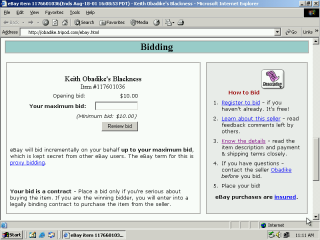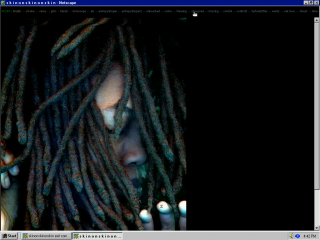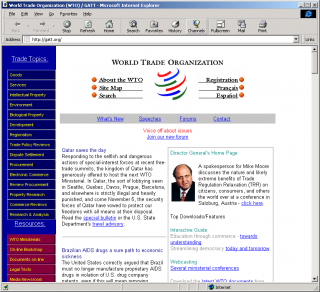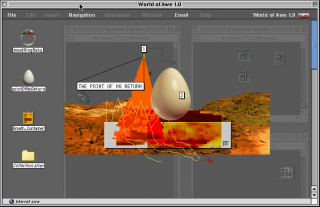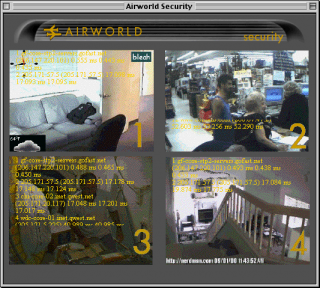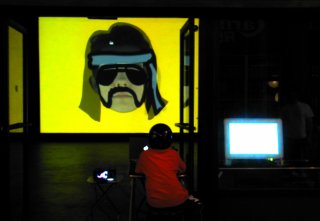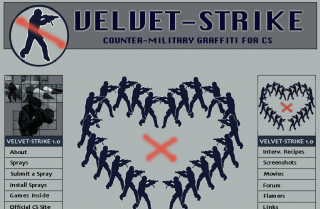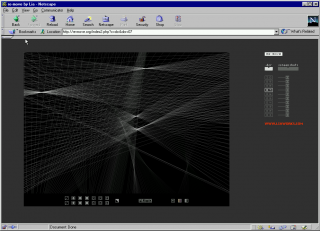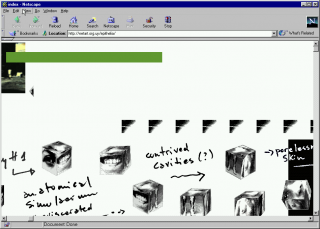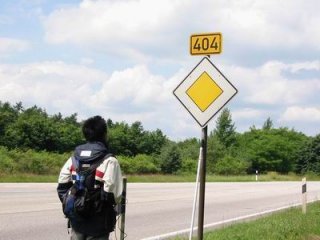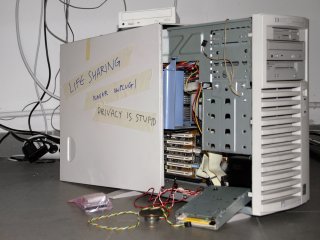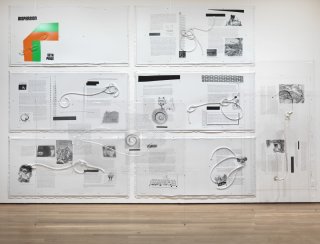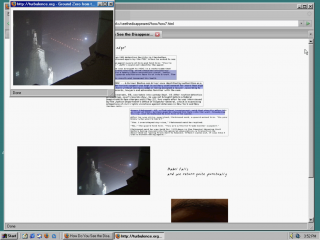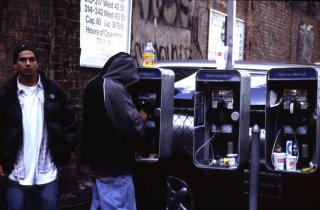Screenfull
Abe Linkoln and Jimpunk
2004 - 2005
In 2004, artists Abe Linkoln (Rick Silva) and Jimpunk (whose real name is a closely guarded secret) began a new blog, hosted on the Blogger platform. Called Screenfull, the project was loud and crowded, taking a maximalist approach to content and design; the artists described it as “stadium rock net.art.”
In keeping with the serial nature of blogging, the artists posted frequently: short looping videos, animated GIFs, images, and audio clips, sampled and remixed from around the web in an ongoing multimedia conversation. At the same time, they worked against the blog format by continuously redesigning their page, creating a dynamic relationship between the posts and the structure of the site itself. The result was a cacophonous, multi-layered digital collage that grew and changed over time.
Building on Jimpunk’s earlier forays into blogging as artistic practice, Screenfull was an influential exploration of the possibilities for net art in the web 2.0 era, as online production increasingly moved from personal web pages to hosted services such as Blogger. Its model of collaborative posting prefigured the later rise of surf clubs, setting the stage for a significant net art practice of in the mid- to late-2000s.
Screencast video of Screenfull recorded in 2017 with Safari web browser. Video courtesy of the artists and Rhizome.
“We crash your browser with content.”
.JPG)
Screenshot of Screenfull created by Jimpunk (JPEG, cropped)
“Screenfull still reminds me of that era of the internet; Myspace, file sharing, RSS feeds, and the first few times I did a Google Image search—a sense of endless media scrolling, looping, popping up, auto playing, crashing.”
—Rick Silva (Abe Linkoln)
In the early 2000s, web culture changed rapidly as new services and platforms were introduced that allowed users to publish online quickly and with little technical knowledge. Called web 2.0, this paradigm shift brought significant changes to internet culture. In place of hand-coded HTML pages, there were template-driven blogs. The time-stamped post replaced the always-under-construction page as the basic unit of web content.
 Screenshot of first post on noblog (Jimpunk and collaborators, 2003) as seen on Google Chrome.
Screenshot of first post on noblog (Jimpunk and collaborators, 2003) as seen on Google Chrome.
Responding to these new conditions, Jimpunk began exploring the blog as artistic medium in 2003 with a project called noblog, inviting dozens of artists to post on a default Blogger site. They went on to set up a second blog, [544x378(WebTV)](http://544x378.free.fr/(WebTV)/FFFFFF.htm), which solicited size-limited contributions of 544 x 378 pixels.

Screenshot of 544x378(WebTV) in Google Chrome, showing post by Abe Linkoln.
Screenfull expanded the format of 544x378(WebTV) from its restrictive pixel cap, instead taking over the entirety of a blog’s format. Instead of inviting numerous collaborators, Abe Linkoln and Jimpunk were the blog’s sole authors. This allowed the blog to take the form of a multimedia conversation, in which the artists responded to one another’s work and developed a shared artistic language.

Screenshot of Screenfull as viewed in Internet Explorer on Windows XP. (JPEG, courtesy of the artists.)
Read Lauren Studebaker’s interview with Rick Silva (Abe Linkoln).
Many of the blog’s posts mix found imagery from the internet with process-oriented Photoshop aesthetics and visual elements of the web’s infrastructure and interfaces. For instance, the posts often make use of Photoshop’s blinking magnetic lasso tool.

Screenshot of Screenfull as viewed in Internet Explorer on Windows XP. (JPEG, courtesy of the artists.)
For their source material, the artists often drew on subjects associated with a certain kind of toxic juvenile masculinity: Travis Bickle, topless models, military vehicles, anime girls, and guns make regular appearances. These subjects were overrepresented in internet culture then as now, and Screenfull’s used them to create a kind of funhouse mirror reflection of the male id fueling so much of the web’s circulatory dynamics.

Screenshot of detail view from Screenfull (JPEG, courtesy of the artists).
Screenfull birthed other, smaller collaborative projects. The artists made thier own net-based radio station, which used similar Dadaistic collaging practices with audio clips.

The two also collaborated on a book documenting the project, which is available as a PDF with embedded video.
Jimpunk and Abe Linkoln also made a sub-site with a focus on Marcel Duchamp-related posts where they posted clever remixes of Duchamp’s most famous works. Duchamp’s use of chance, his everyday found materials, and his anti-art provocations made him an important precursor for Screenfull. As Thierry de Duve wrote, Duchamp “equated art with making, and making with choosing.”
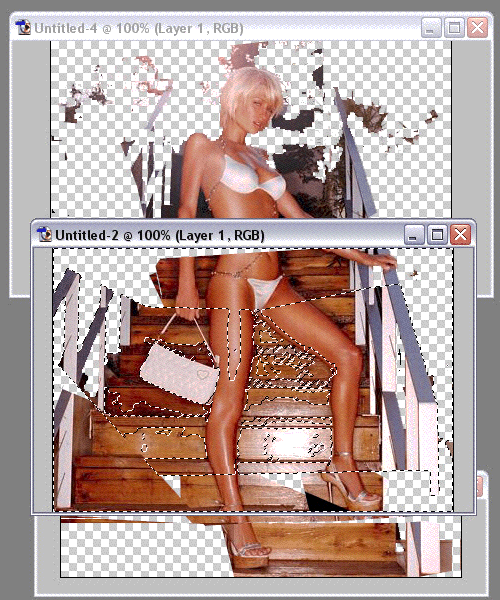 nude descending a staircase (abe linkoln’s 2004 mix), Abe Linkoln. (JPEG, courtesy of the artists.)
nude descending a staircase (abe linkoln’s 2004 mix), Abe Linkoln. (JPEG, courtesy of the artists.)
Screenfull is an important early example of net art’s response to web 2.0. It made use of the unique possibilities of the Blogger service, but it also attempted to break the format. In the coming years, artists would increasingly embed their work in broadly available services and infrastructures, while also calling these services into question.
“More than a decade later I see Screenfull as a kind of inbetween project in the net art 1.0 and 2.0 historical perspective—somewhere between hacker and default, between stand alone sites and social media.” —Abe Linkoln
In subsequent years, artists would increasingly sample, remix, and recirculate existing elements of the consumer web. In many cases, they would do so as part of surf clubs, which Paul Slocum defines as “group artist blogs where the prevailing subject is internet culture and aesthetics and where lines are blurred between the roles of artist, curator, and archivist.”

Screenshot of Screenfull as viewed in Internet Explorer on Windows XP. (JPEG, courtesy of the artists).
Predating the launch of YouTube by one year, Screenfull made extensive use of embedded QuickTime video. It can be seen in Safari if the QuickTime plugin is enabled, but would ideally be viewed in an environment such as Internet Explorer on Windows XP, which is not yet available via online emulation. Therefore, it is presented as part of Net Art Anthology in the form of a screencast video, embedded above.

